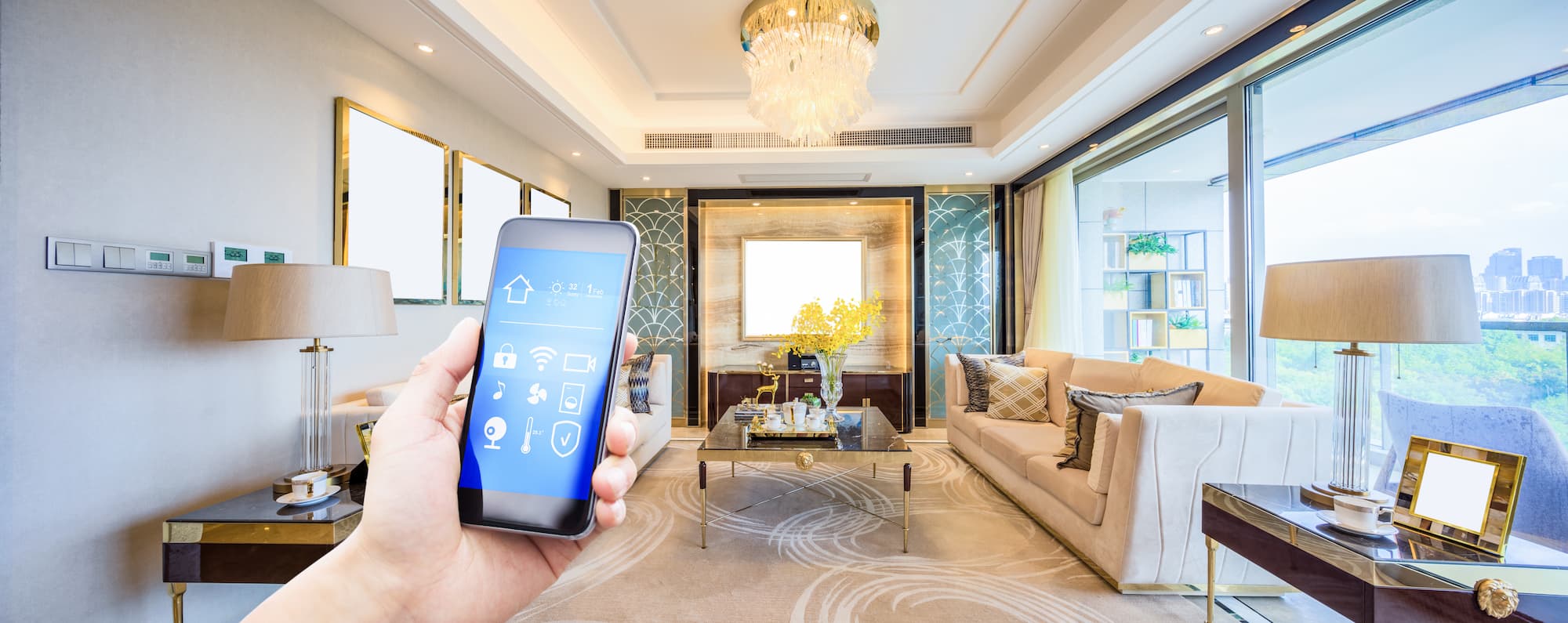What Is Home Automation and Should You Do It?
What You’ll Learn
As you read this description of home automation, you’ll learn:
-
- There are many different home automation applications, which means it’s easy to customize your smart home for your lifestyle.
- The benefits of home automation include things like increased safety, convenience, and comfort.
- You can gradually turn your house into a smart home, or you can have professionals start you off with one big project.
What Is the Meaning of Home Automation?
Home automation, also known as smart home technology, describes the use of technology to automate processes around the home. It involves the Internet of Things (IoT), which is the entire collection of physical devices connected to the internet. It’s now possible to effectively control almost every aspect of a home by leveraging the IoT and smart home technology.
There are some aspects of home automation that you’re probably already familiar with. One early example is the thermostat. Programmable thermostats have already been around for a few years, and many people have already become comfortable controlling them through their smartphones and other interfaces. That same technology has now been applied to many other different types of devices. In this guide, you’ll learn all about smart home technology, what can be automated, and the benefits of turning your house into a smart home.
What Is Home Automation and How Does it Work?
It’s hard to explain exactly how home automation works in great detail because this technology is so new and complex. Many leaders in the space don’t even share all of the details of their developments because they don’t want to give up a competitive advantage. To put it simply, though, home automation uses the internet to allow devices to communicate with and control each other. If you have a Wi-Fi network and electricity, your home can become a smart home.
Types of Home Automation Systems
The automation of a home typically runs through a central control station. This system can normally be accessed through a terminal that’s mounted on the wall. You might see such a terminal on the wall of an upscale business, a luxury home, or any other place with great technology. The central control system may also be accessed through a remote control device or on personal devices like smartphones, tablets, and computers. Since there are so many different ways to engage with home automation, it’s possible to manage tasks from just about anywhere.
The primary benefit of having a central control system is that you can go to one place in your home to control everything. This becomes especially helpful as you build out your smart home, adding more devices and processes. These are top-of-the-line products, which generally means they offer great quality, smooth user interfaces, and dependable function. They have to be installed by a professional, which helps homeowners ensure that everything is done correctly.
Of course, there are also benefits to having an app or another way to access your smart home control center remotely. This way, you can make small changes or check on the status of various devices without getting up and going to the wall-mounted interface. This also allows you to make changes on the go. For example, you may choose to start some appliances while you’re on your way home from the office or airport.
What Is the Use of Home Automation?
There are many different ways to use home automation, so it really depends on what you want and what you value from home. If you want to add function and convenience, you can add features to give yourself a smart kitchen, smart pet care, a smart bathroom, a smart nursery, and some other general smart home basics. If you want to improve the security of your home, that’s also a great use of smart home technology. The various applications of home automation are useful for people of all ages and are surprisingly easy to master.
Best Smart Devices for a Home Automation System
There are numerous different categories of home automation devices. Before getting too far into your smart home design, though, it’s best to make sure the basics are covered:
-
- Smart TVs – Take more control of your streaming whether you have cable or not.
- Smart Speakers – These are the perfect pairing for smart TVs, and they can help you develop an entire smart entertainment system.
- Smart Thermostats – Save energy and make your home more comfortable by leveraging this technology that lets you set routines or adjust the temperature from anywhere.
- Smart Plugs – Instead of turning devices on or off manually, you can leave them in the on position, then turn the plug on and off from your smart home control station or app.
- Smart Lights – Automate lighting routines, change the lighting color, and set a dimmer to create the perfect lighting plan.
- Smart Doorbells – Video doorbells add a great deal of convenience and security, which makes them especially popular.
- Smart Vacuums – Don’t have the time or energy to vacuum all of the time? Let a robot vacuum do the work to keep your floors clean.
Smart Kitchens
Once you’ve covered the basics, you may want to move on and take your kitchen to the next level.
-
- Smart Refrigerators – These refrigerators can tell you if the door is left open or even let you know when it’s time to buy more of certain products.
- Smart Ovens – Set the temperature, control the timer, and run various other diagnostics.
- Smart Dishwashers – Start and stop loads remotely, check the status of your load, and get notified as soon as the dishes are clean.
- Smart Laundry – While laundry isn’t normally in the kitchen, the function of these devices is very similar to some of the others on this list. You can start, stop, pause, and check the status of your loads.
- Smart Slow Cooker – Turn it on and off, check the temperature, and adjust other settings. This is perfect for loading before work and turning it on at the appropriate time, so it’s done when you get home.
- Smart Trash Cans – These no-touch options also have odor control built-in in many cases.
- Smart Buttons – You can use Amazon dash buttons to order products automatically. For example, when you’re running low on dish soap, simply press the button by your dishwasher, and it will automatically order more for you.
Other Smart Products
Now that you have an idea of what’s possible, you might start to see that every room of your house can be automated. Bathrooms, nurseries, and more can all be revitalized with technology. You can even automate aspects of your pet care.
What Is the Difference Between Smart Home and Home Automation?
These words are often used interchangeably. The only notable difference is that a smart home is a place and home automation is the process.
Home Automation in San Francisco
Here at Performance Audio, we’re very familiar with home automation technology. Our experts can help you design the perfect plan for your home and lifestyle, then execute that plan to perfection. Contact us today to get started!
Featured Image: zhu difeng/Shutterstock





